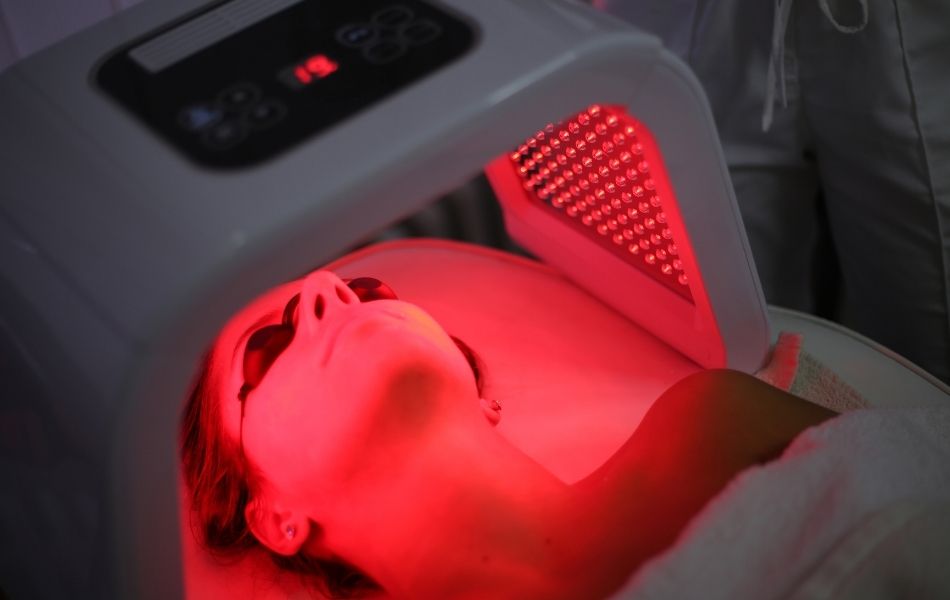If you’ve ever scrolled through skincare TikTok or seen a futuristic-looking mask glowing red or blue, you’ve probably come across light therapy. It may look like something out of a sci-fi movie, but this treatment is a proven, dermatologist-backed method to enhance skin health.
From calming acne to boosting collagen, different types of light therapy can help your skin look and feel better—without needles, downtime, or harsh chemicals. Let’s break down what it is, how it works, and which type might be right for you.
What Is Light Therapy, Anyway?
At its core, light therapy (also called phototherapy) uses specific wavelengths of light to target different skin concerns. It’s not UV light—so there’s no risk of sunburn or skin damage. Instead, we use safe, visible light that penetrates the skin to different depths, triggering natural healing processes.
Light therapy is commonly used in dermatology offices to treat acne, inflammation, eczema, psoriasis, and even signs of aging. Some versions are available for at-home use, though in-office treatments are stronger and more precise.
Types of Light Therapy
Not all light is created equal—and in skincare, the color of the light matters. Different wavelengths (or colors) reach different layers of skin and have unique effects. The two most common are red light therapy and blue light therapy.
Red Light Therapy: The Skin Rejuvenator
If you’ve ever wondered, “What does red light therapy do?”—you’re not alone. Red light therapy utilizes low-level red light (typically ranging from 630 to 700 nanometers) to penetrate deeply into the skin.
So, what does red light therapy do for your skin? In short, it helps your skin repair itself. It boosts circulation, reduces inflammation, and stimulates collagen production—the protein that keeps your skin smooth and firm.
Benefits of Red Light Therapy
- Improves fine lines and wrinkles
- Enhances skin texture and tone
- Reduces redness and inflammation
- Promotes faster healing from acne or procedures
- Calms conditions like rosacea and eczema
Think of it as a workout for your skin cells. They absorb the light energy and convert it into fuel for renewal and repair—helping you glow from the inside out.
Blue Light Therapy: The Acne Fighter
Now, let’s talk about blue light therapy, the go-to for acne-prone skin. If you’ve ever asked, “What does blue light therapy do?”—here’s the scoop. Blue light (around 415 nanometers) targets the skin's surface, where acne-causing bacteria live.
When this bacteria is exposed to blue light, it triggers a reaction that essentially destroys it—no antibiotics or harsh scrubs needed.
Benefits of Blue Light Therapy
- Kills acne-causing bacteria
- Reduces active breakouts and prevents new ones
- Helps control oil production
- Soothes inflammation from acne lesions
It’s especially effective for mild to moderate acne, and when combined with red light therapy, it can help calm inflammation while helping prevent future breakouts.
Is Light Therapy Effective?
Short answer: yes—when done consistently and under the proper guidance. Light therapy is effective for many skin concerns, primarily when used as part of a customized skincare plan.
For acne, blue light therapy can significantly reduce bacteria and inflammation after a series of treatments. For aging or sun-damaged skin, red light therapy helps stimulate collagen and improve overall skin tone. The key is patience—results build gradually as your skin regenerates.
How Often Do You Need Light Therapy?
Frequency depends on the condition being treated and the type of light used.
For acne: Blue light therapy is typically performed 1–2 times per week for several weeks until improvement is seen.
For anti-aging or healing: Red light therapy may begin with 2–3 sessions per week for the first month, then taper to maintenance treatments every few weeks.
As your skin responds, you can often reduce the frequency; however, some patients choose to maintain occasional sessions to keep their results. Think of it like going to the gym: consistency is key early on, but once you’re in shape, you can maintain with less frequent visits.
What Does Light Therapy Feel Like?
Most patients describe light therapy as a relaxing experience. There’s no pain or downtime—just a gentle warmth or tingling while the light does its work. You can even read, nap, or listen to music during your session. Afterward, your skin may appear slightly flushed for a short time, but there’s no peeling or irritation, unlike with other treatments.
The Bottom Line: Is Light Therapy Worth It?
If you’re looking for a safe, non-invasive way to boost your skin health, light therapy is definitely worth considering.
Whether it’s red light therapy to promote healing and boost collagen or blue light therapy to manage acne, this treatment can be tailored to your skin’s needs and goals.
So, the next time you see that glowing LED mask or hear someone rave about their “light therapy glow,” you’ll know exactly what’s happening under the surface—and why it works.
Ready to Learn More?
If you’re curious about which type of light therapy is right for your skin, schedule a consultation with your dermatologist. They’ll help tailor a plan using the best light wavelengths for your skin type, tone, and goals—because everyone deserves their moment to shine.
At Dermatology Partners, our experienced providers offer customized red and blue light therapy treatments to help you achieve clearer, healthier skin. Reach out to your nearest Dermatology Partners location today to schedule an appointment and find out if light therapy is right for you.



